FAQ
The short answer is yes! For the prevention of periodontal disease, brushing the teeth daily is the gold standard of care.
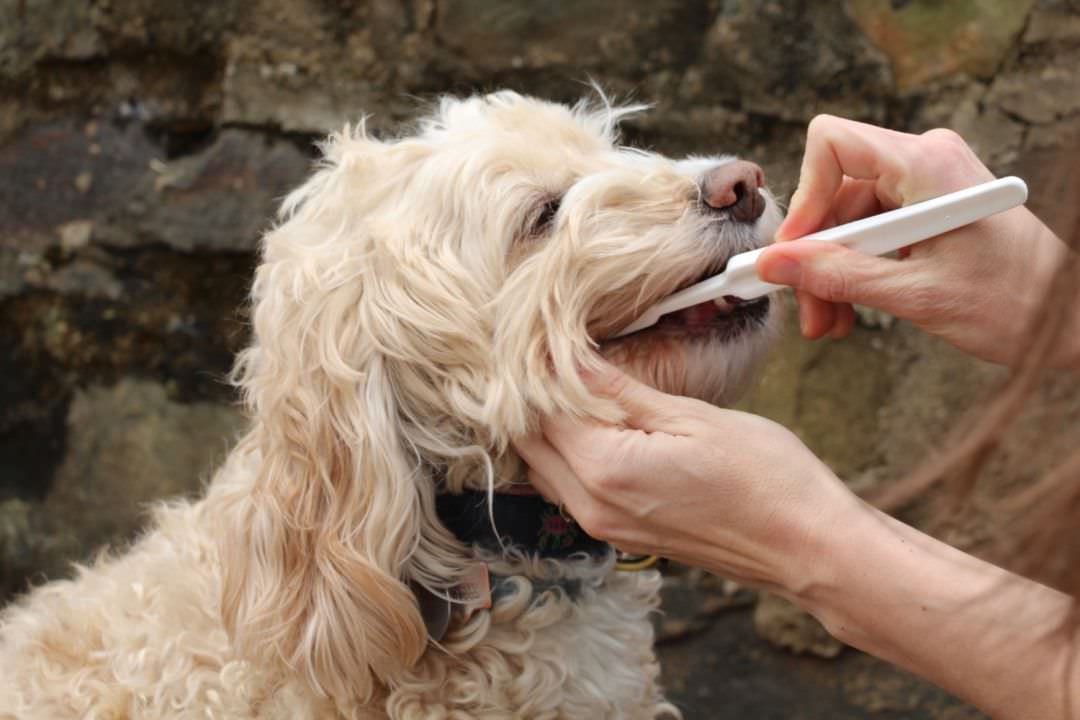
- How often should I brush?
- Brushing should ideally be performed once daily. Our own habits are easiest to form if we are consistent with them, and this includes brushing our pet’s teeth!
- How do I get my dog/cat to accept brushing?
- It is recognized that not all dogs or cats will willingly accept tooth brushing. There are many good videos and tutorials online about teaching your pet to accept brushing. The key to training is to make brushing a positive experience and start introductions to brushing slowly. You can look through the posts @mypetssmile on Instagram as we have put some tutorials on there as well.
- Should I use toothpaste?
- Do not use human toothpaste on pets as it is not meant to be swallowed and can be toxic.
- There is no strong research to suggest that pet toothpaste kills plaque bacteria, so you do not need toothpaste to accomplish plaque removal. It is the mechanical aspect of toothbrush bristles that clean the teeth, not the paste.
- Toothpaste can be helpful for training if your pet enjoys the taste of it. However, if they are eating it while you are trying to brush, this makes brushing more difficult.
- What toothbrush should I use?
- There are a large variety of toothbrushes made for dogs and cats, so pick one that works for your particular situation. Human toothbrushes work well for the larger dogs.
- A gauze square can be used as an abrasive surface to wipe along the surface of the teeth if you find it difficult to use a toothbrush.
- Limitations of brushing:
- Scientific research has demonstrated that the best human toothbrushers will still miss removing plaque on up to 20% of the tooth surfaces. Additionally, reaching all surfaces of the teeth (especially the inner surfaces and the back of the teeth) is nearly impossible in an awake animal. For that reason, brushing does not substitute for regular professional care with your veterinarian. Your vet should be able to guide you on how often your dog/cat requires more advanced care.
- There is no “one-size-fits-all” for how often our patients need professional care. Do not be tempted by veterinary “health-care plans” that offer cleanings as part of a package. Every patient is an individual and should be treated as such. With these plans, it is possible that your cat or dog will either receive care more or less frequently than needed.
- How often should my pet’s teeth be cleaned professionally?
- Every animal is different on what their requirements for dental care will be. Some dogs and cats will have good teeth throughout life with no dental intervention at all, while some will suffer from periodontal disease even with daily brushing and regular professional care. Genetics and size often play a role in need for dental care. For that reason alone, dental care recommendations should be tailored for each individual animal.
When it comes to signs of dental disease in dogs and cats, please think about the following:
1st– Cats and dogs are notoriously good at hiding signs of pain. That is their nature!
2nd– Eating is an incredibly strong drive for animals, so if they stop eating altogether, it is often a serious internal medical issue. Dental problems rarely cause a loss of appetite. We should not use the fact that our dogs/cats are eating as a reason to ignore dental disease.
3rd– Our patients can’t tell us what hurts, what is sensitive to hot/cold, where the toothache is, etc… For that reason, we veterinary dentists are here to be advocates for our patients and to make sure they don’t suffer from unrecognized pain. What is uncomfortable/painful for a person (broken tooth, periodontal disease, etc…) is uncomfortable for our dogs and cats.
Things that every pet parent should be looking for as a visible sign of a problem include the following:
- Broken tooth
- Halitosis/ Bad breath
- Red/inflamed gums
- Facial swelling
- Oral growths
- Discolored teeth
- Heavy discoloration/tartar build-up on the teeth
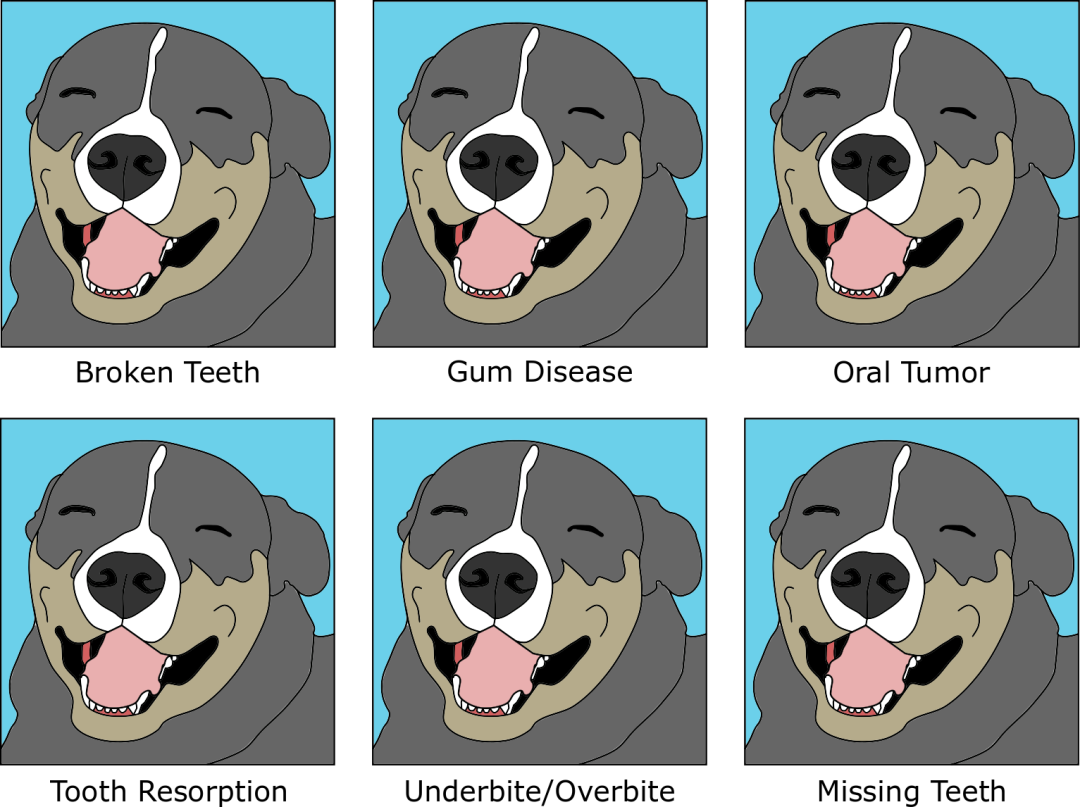
Here are some behaviors that can be associated with dental disease:
- Excessive salivation (this is also often attributed to nausea or GI discomfort, so a general exam is in order if your dog or cat is having this problem)
- Difficulty chewing/change in chewing behavior
- Change in food preference (dry vs canned or vice versa)
- Dropping food
- Change in play behavior/preference for toys
- Pawing at the face
- Vocalizing while eating, hissing at the food bowl (cats)
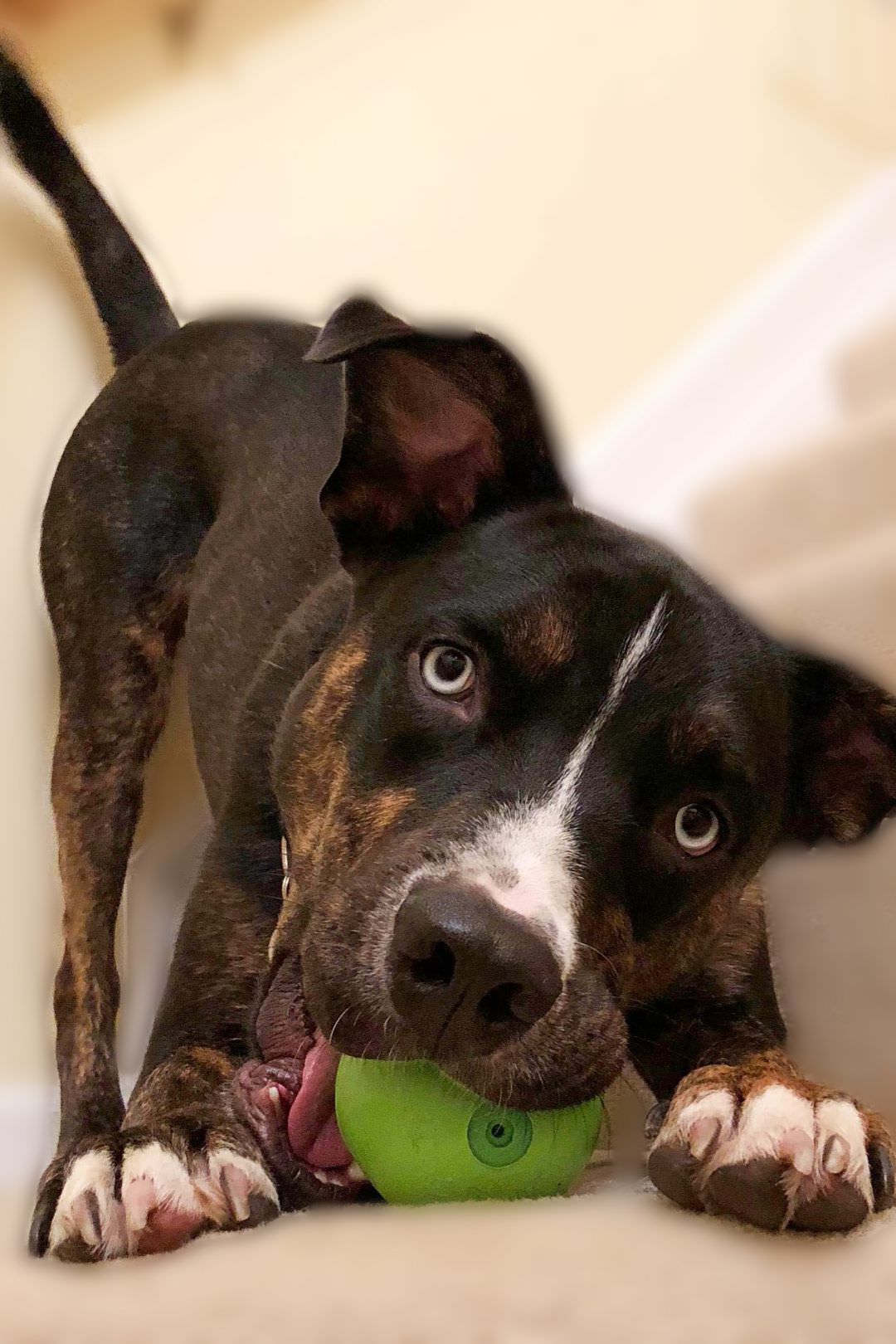
Safe Chew Objects:
Fractured teeth are commonly encountered in veterinary medicine. If the pulp is exposed, fractured teeth are very painful and lead to infection if untreated. In most cases, fractured teeth are caused by chewing on inappropriately hard objects. Remember this when thinking about what to give your dog to chew on: dogs and cats are carnivores, and thus the function of their dentition is to grasp, pull, and hold prey. The teeth are therefore designed to cut and tear meat and swallow large pieces whole. Dog dentition is not designed to chew bones or objects harder than the teeth, and those starving animals that do so in the wild often end up with fractured dentition, which then puts them at a survival disadvantage. For our companion animals, dental treats and chew objects should be considered as mental stimulation and preventative dental care in conjunction with daily brushing and regular professional care. So although chewing is extremely important for both mental and dental health, we certainly want to make sure to choose chew objects wisely.
One of the most common questions I get asked is, “what is safe and appropriate for my dog to chew on?”. This is a very difficult question for me to answer because one size does not fit all in the chewing category. What I mean by that is that some dogs don’t tolerate rawhide well, some dogs don’t want to chew on rubber toys, some dogs chew too aggressively and eat toys that aren’t meant to be eaten or choke on them, some dogs break teeth quicker than others, etc..,etc… So please understand that there is no perfect answer to what a dog should chew on. I personally don’t follow the mantra “it should be soft enough to hit your knee with it in order to give it to your dog.” I wouldn’t hit my knee with any dog chew toy, ouch!
To help you make your decision on chew items that might be good for your pup, I created the chew rating scale. This scale is based on items that are so hard that I see teeth commonly fractured on them (i.e. elk antlers) all the way to items that have some benefit to the teeth while chewing but have almost zero likelihood of breaking teeth (dental treats, carrots, etc…). Hopefully this helps to make your decision on what to let your dog chew on easier.
Things that every pet parent should be looking for as a visible sign of a problem include the following:
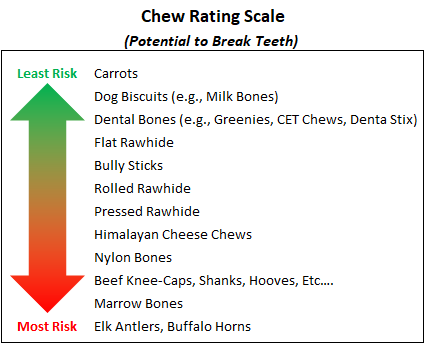
If you can drive a nail with the toy your dog is chewing on, take it away! The flatter, soft rawhides have been shown to be safe for teeth and are effective in reducing plaque build-up. However, some dogs do not tolerate rawhide well and some will try to swallow a large piece whole, which can become a choking hazard. If using these, I recommend getting a size meant for a dog much bigger than your own and taking it away when it gets small.
Tennis balls
As much as I love playing tennis, these balls should stay on the court and not in your dog’s mouth. These have an abrasive coating that is just way too rough on teeth! If your dog is only an occasional fetcher, they are probably okay. But for the obsessive ball players out there (Labs, Goldens, herding breeds), avoid tennis balls altogether and stick with a smooth surface ball.
Safe Toys/Chews:
Fortunately, there are countless safe toys and chews out there that are made for the chewer in your life. These toys are often made of rubber material, and some even stand up to the most aggressive of chewers out there. Here’s a list to get your started. (note: I have no financial relationship or otherwise with any of these companies nor to I stand by the fact that any of these toys are indestructible or safe. Please monitor your dog’s chewing and playing at all times).
- The Kong brand makes a plethora of rubber toys for you to choose from. Kong sells their toys at most pet stores and online.
- Halitosis/ Bad breath
- There are a number of treat balls and puzzles out there that are great for your dog’s mind and mouth! I recommend doing a search on google for interactive chew toys/ rubber puzzle toys/ soft chew puzzles. So much fun to be had with your pup while keeping their teeth sparkly clean! For the kitty owners out there, mental stimulation with food games is a huge bonus for your indoor cat!
- Goughnuts: These are some of the most durable chews out there and are made of rubber, so they are dental safe! They also make interactive toys for the busy minds out there.
- West Paw Zogoflex brand makes a bunch of chew safe balls and toys that are durable and fun.
Dental Treats:
Dental treats have become a big market in the pet industry. One has to choose wisely and not fall prey to marketing gimmicks that promise glowing teeth with no brushing or dental care involved. However, there are safe chews out there that are geared towards making mouths healthy. No dental treat will replace brushing or professional care, but some can certainly benefit the mouth.
There are too many dental treats out there to list them all here, but some that are known to be safe and effective are the following:
- Greenies (for cats and dogs)
- Dental Diets such as Hill’s T/D
- Virbac CET VeggieDent chews (reminder that I do not have any financial or other relationship with any of these companies)
Disclaimer #1:
It is true that some dogs will chew on nylon or other hard bones throughout their entire lives and never break a tooth. But it is also possible that a dog will chew on one for 5 minutes and break three teeth all at once (mine did!). This page is well-intended advice on what is safe for teeth, but there is no “one-size-fits-all” category for safe chewing in dogs. Please check your dog’s teeth regularly for fractures, regardless of what they chew on, and make sure to stay up-to-date on regular veterinary care and examinations.
Disclaimer #2:
Always monitor your dog’s chewing as many chew toys and bones can be destructible and choking hazards if chewed too aggressively.
There is no solid research that supports many of the dental health claims made by manufacturers of diets, treats and chew objects for pets. The masticatory forces on food can create frictional forces that are physically able to prevent accumulation of plaque, and even remove it. Where this beneficial effect occurs is at the incisal or cusp areas of the teeth. These same forces, however, are less effective at the gingival margin where the plaque and calculus accumulations are most important. Therefore, the natural cleaning forces of mastication, and the food type, are limited to the regions of the tooth that are at less risk for periodontal disease. For that reason, dental treats and chew objects should be considered as a small part of preventative dental health care. In conjunction with daily tooth brushing and regular professional care, dental diets, toys and treats can play an important role in oral health care maintenance.
Dental diets can effectively reduce some plaque and calculus accumulation, but do not eliminate it. Hill’s prescription diet Canine and Feline t/d® and Science Diet Oral Care® are both balanced nutritionally and have a good “mesh type” effect. Dietary fibers are arranged more parallel than many of the dry foods, and the kibble is larger, forcing the teeth to penetrate the kibble rather than shattering it, thus providing additional abrasive action to help keep the teeth cleaner above the gum line. Eukanuba Dental Defense Diet, Friskies Dental Diet and Royal Canin Diets contain a chemical coating (polyphosphates) on their kibble. This chemical is activated in the mouth and safely delays calculus (tarter) build-up. It is important to understand that dental diets have limited effectiveness and do not replace the need for tooth brushing and professional cleanings. This is especially important to appreciate for those pets that already have periodontal disease.
Drinking Water Additives:
There is relatively little scientific research to support the claims made by many manufacturers of water additives and oral sprays for adequate plaque control. Where the desire is to make “evidence-based” recommendations, the evidence for support of these products is low. There are serious health risks associated with some of these products that are actually available over the counter. Some of the sweeteners (Xylitol) used are known toxins for animals. Additionally, many products contain a large amount of alcohol. It is recommended that additives only be used with your veterinarians’ direction. Oral bacteria produce gases which account for the halitosis (bad breath) associated with gum disease. Various products are designed to reduce this oral odor, however, they may be doing nothing towards actually eliminating the bacteria.
Oral Antiseptic Products:
These are chemical plaque control products. The only ones in this category worth mentioning are those containing 0.12% Chlorhexidine gluconate (CHX). CHX products are excellent for patients with established periodontal disease. CHX is the gold standard oral antiseptic. CHX products are generally prescription products that should only be used under the direction of a veterinarian. Although CHX can stain the teeth, the staining is usually of the plaque and calculus and is removable. This is the most effective antibacterial (also antiviral) agent that can be utilized in the mouth and it works by binding to the teeth and other oral tissues. It is slowly released into the oral cavity over a 12-hour period. Chlorhexidine rinses are also good for cats; however, some tolerate the flavor & others do not.
Several products contain zinc ascorbate. This has antiseptic properties, but also benefits gingival health by promoting collagen formation and epithelialization of ulcerated tissues. Maxiguard™ oral formula is an example of this type of product. It can be beneficial after oral surgery for its antimicrobial effects.
Chew Objects:
Strictly avoid bones (cooked or uncooked), cow hoofs, pig ears, hard & thick rawhides, plastic or nylon bones, plastic bottles, any antlers and large ice cubes. Tennis balls and other objects with abrasive surfaces should also be avoided as these have a sandpaper like effect on tooth structure that damages the tooth and may expose the pulp. The flatter, softer rawhide chews have been shown to be safe and effective in reducing the rate of plaque accumulation. Kong toys are of a firm rubber design, come in a variety of shapes & sizes and some allow you to place cheese or peanut butter inside to improve acceptance. For cats, C.E.T. Oral Hygiene Chews for cats contain products that help provide antibacterial effects in the mouth.
Take note: you must always monitor your pet when they are chewing on anything. Verify they’re not gagging, trying to ingest too much at one time or attempting to eat an inedible product. Please refer to Animal Dentistry & Oral Surgery’s article on Safe and Appropriate chew objects.
A Note On Marketing:
As pet owners become more and more aware of dental health in their dogs and cats, development of products and use of questionable marketing methods will increase. One such method that is currently very popular is the advertisement of “brushless” dental products. There is no product in the world that will penetrate either plaque biofilm or the hard build-up of tartar. Mechanical removal is the only way to remove these. Would you go back to your dentist if they told you to stop brushing and instead just use a mouthwash? I hope you would find a new dentist, because that would not work! If you cave to these marketing gimmicks, you may end up spending money on mostly useless products that give you a false sense of security and potentially harm your pet with questionable ingredients. Nothing substitutes for regular professional care and tooth brushing.

There can be many causes of bad breath (halitosis), including GI disease, kidney disease, and lung disease, but the most common cause is poor oral hygiene. When plaque bacteria build-up on the teeth, these bacteria breakdown food particles and produce sulfur compounds which are very smelly! Further, when gum (periodontal) disease is left unchecked and these bacteria gain access under the gums (called periodontal pockets), the odor gets exponentially worse. For that reason, significant halitosis can mean that your pet is suffering from advanced periodontal disease. The best way to determine the cause of bad breath is to visit your veterinarian and have a physical and oral examination done.
What’s the best way to treat bad breath?
If it is caused by gum disease, the first thing to do is to have a professional oral examination and cleaning performed under anesthesia. It is essential that dental x-rays are performed along with a thorough examination to evaluate for pockets of disease that may not be visible on an awake examination. If these pockets are not properly eliminated/treated, then the bad breath will continue after the cleaning. This is just one reason why anesthesia is so important!
After your dog/cat’s mouth has been treated and all plaque and calculus have been removed, you can start home-care to ensure that your dog or cat’s mouth stays happy and healthy. See our articles on home-care to make sure that you are doing everything you can to keep those pearly whites smelling good!
How will my dog/cat eat if he or she has teeth removed?
This is a question I answer multiple times a day. I, more than most, understand this because every animal I’ve owned has lost one or more teeth in their life-times (and a couple had/have no teeth!). I am here to assure you that they ALWAYS feel and eat better once diseased teeth are removed from their mouths.
Why Extract Teeth?
As veterinary dental specialists, we are often able to provide treatments that would be an alternative to performing extraction of a dog or cat’s teeth. Unfortunately, there are certain circumstances in which it may be in your pet’s best interest to have one or more teeth removed. The main indications for which we may recommend extraction(s) are when tooth-related infection, pain or other oral diseases cannot be reasonably controlled by other means.
Because of some anatomical differences, most veterinary extractions are actually more difficult than extraction of a human’s tooth. Cats and dogs are carnivores and therefore their root structures are deep into the surrounding bone. Surgical approaches for extractions are the most efficient and safest means of tooth extractions for pets. Many roots are fragile and closely located to other important anatomical structures like major blood vessels, nerves, nasal cavity and even the eye. At Animal Dentistry & Oral Surgery, most extractions are performed surgically and even “simple” extraction sites are closed surgically. We do not leave open “sockets” to heal on their own. Closed extractions sites are much more comfortable for the patient, healing is faster and far fewer complications occur. Improperly performed extractions can cause problems and these often go undetected because our pets cannot communicate their discomfort.
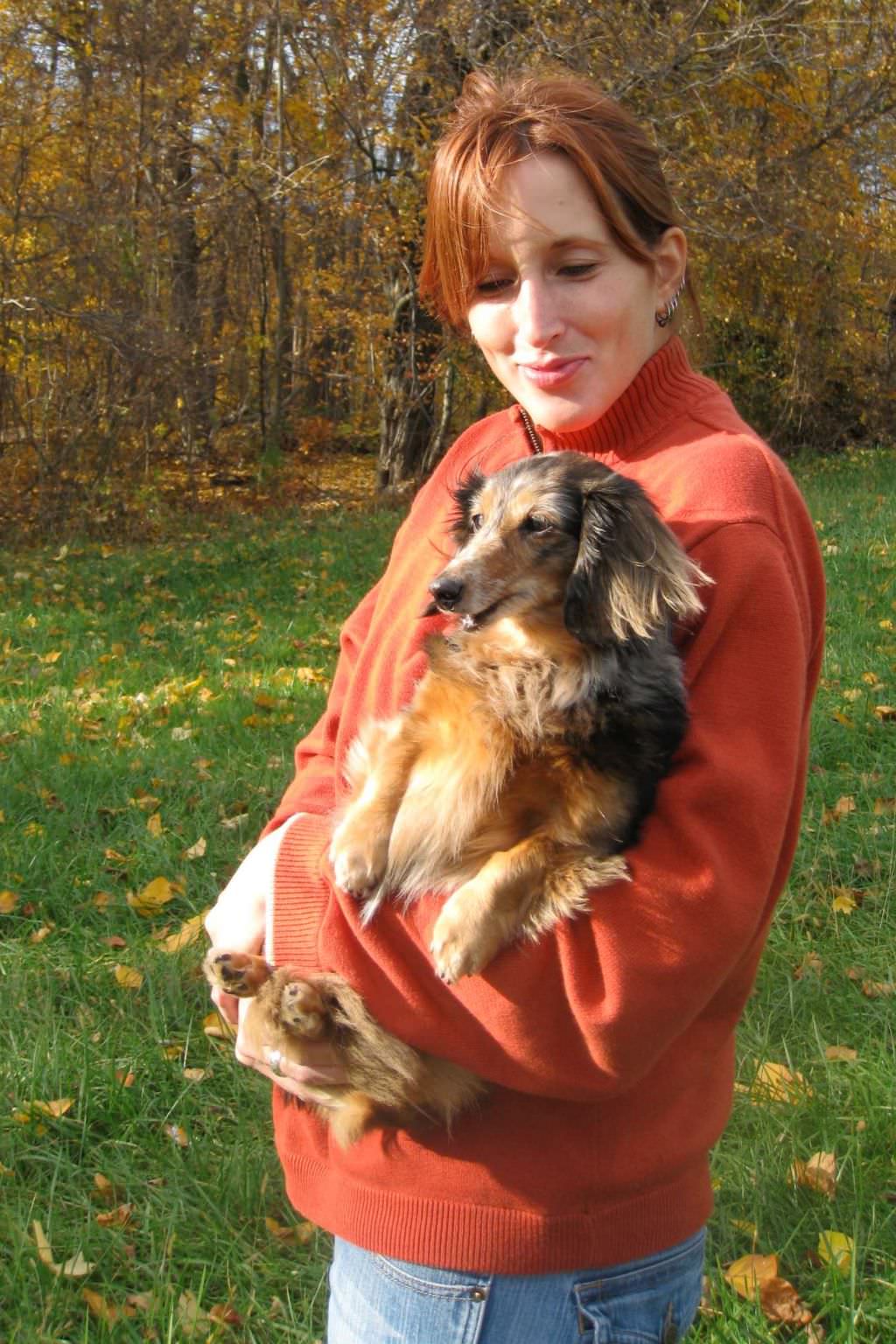
Questions About Pet Teeth Extractions:
Q: Will my pet’s teeth shift after they are extracted?
A: Unlike human teeth, which will shift if one tooth is extracted, dog or cat teeth do not shift. This has to do with differences in the size, shape, root structure, bite forces and intent for function (humans are chewers, carnivores are cutters).
Q: Will my pet get “dry socket” after extractions?
A: Dry socket is a relatively common post-extraction complication in humans. It occurs because most extraction sites are not surgically closed. This complication is unlikely when the extraction site is properly treated and closed surgically. Sutures are absorbable and do not require removal.
Q: Will my pet be able to eat after having teeth extracted?
A: Many clients are concerned about their pet’s ability to eat after extraction procedures. It is important to remember the reason why a tooth may need to be removed. In almost all cases, it can be stated that the pet will do better without the teeth. Getting rid of sources of infection, inflammation and pain are very important to health and well-being. We can often ask a counter question; do you really believe that your pet is chewing with a tooth diseased to this extent? Remember that our pets are carnivores and do not chew like humans. Humans are chewers and grinders. Carnivores are cutters and gulpers. The reason so many pets seem to do so well with badly diseased teeth or when they have no teeth is that they have an existing mechanism for swallowing most of their food whole. Many cats and dogs with perfectly normal teeth do very little or no chewing. If the food is an appropriate size for swallowing whole, they will!
As far as immediate post-procedure eating concerns, surprisingly, most patients (even with numerous teeth extracted) will be able to eat soon after their procedure. Most dogs or cats will eat the night of the veterinary dental procedure or the following morning.
Often if your pet enjoyed eating dry food prior to the procedure they will likely be able to return to a dry food diet after their extraction sites have completely healed. In fact, some pets with no teeth will prefer to eat hard food. This sounds ridiculous because they have no teeth, but kibble is often small enough that it can be easily prehended, manipulated and swallowed whole without difficulty.
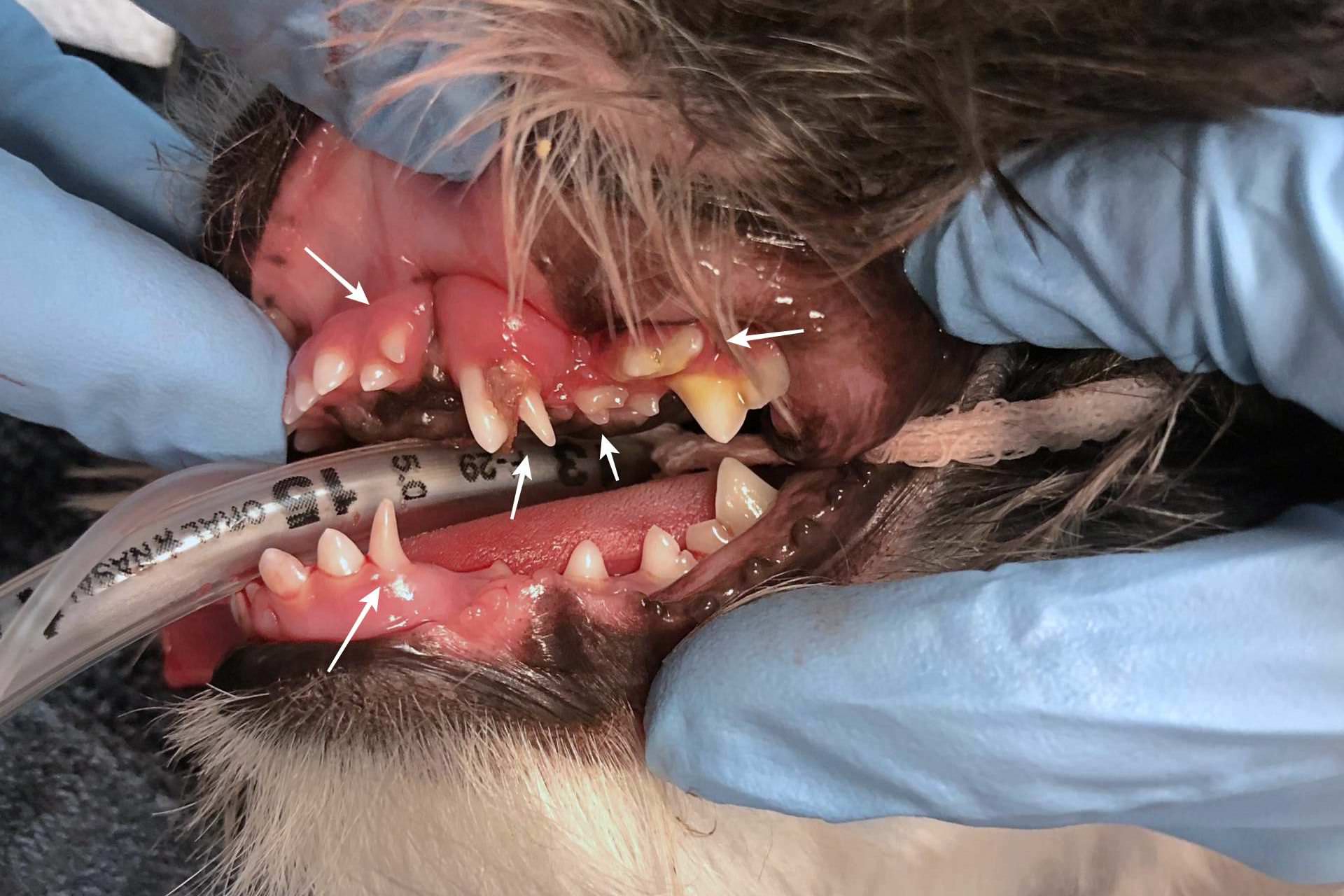
If your pet is about six to eight months old, all of their puppy or kitten (deciduous) teeth should have fallen out. If you are seeing adult teeth come in and the deciduous teeth are still present, they may not fall out on their own. Generally speaking, a baby tooth and an adult tooth should never be present at the same time.
This is a concern because the puppy’s or kitten’s deciduous teeth may prevent the adult teeth from reaching a normal position in the mouth. When the teeth are not aligned properly, they could cause damage to other structures and cause pain and discomfort. This condition may mean that your pet could need orthodontics or surgery to correct the problems. Additionally, overly retained baby teeth cause problems with crowding, which can lead to build-up of debris and eventual periodontal disease/bone loss. An evaluation by a veterinary dentist will help you determine what options you have to address these issues.
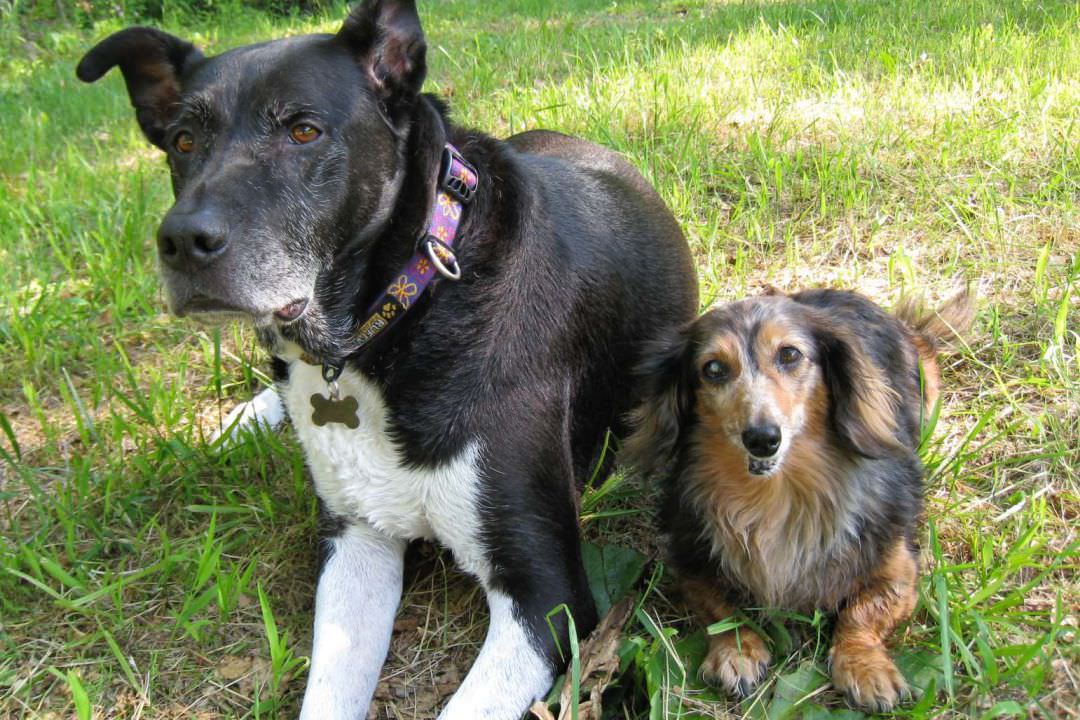
At Animal Dentistry & Oral Surgery we are pet lovers, so we understand your concern. We always indicate that there are risks associated with anesthesia, which is why it is important to evaluate any patient fully prior to anesthesia to determine if an anesthetic procedure will be safe for them and that the risk will be warranted to address the level of disease that is present. When you choose a highly-experienced veterinary dentist, you can be assured your pet is in the best of hands.
Pre-operative testing including a Complete Blood Count (CBC) and Biochemistry Profile will help us to determine if there are issues with the organs or with the blood counts that may be of concern. A urinalysis and thyroid evaluation may also be recommended. Further testing depending on the results of a CBC or biochemistry profile may be recommended prior to anesthesia.
Depending on the age of the dog/cat and if a heart murmur or arrhythmia is noted, an evaluation by a cardiologist might be recommended to determine if the heart disease/issues will pose a higher risk of a complication intra- or post-operatively.
Your pet’s safety under anesthesia is our priority and we take precautions to minimize the risks of serious complications under anesthesia. At ADOS, we monitor each pet very closely under anesthesia and a registered/licensed technician is monitoring your pet’s vital parameters at all times.
In conclusion, often, the benefits of treating the dental disease far outweigh the risks associated with anesthesia. A consultation with an ADOS dentist can help you determine the safest ways to address your pet’s dental disease.
What is a veterinary dentist?
A veterinary dentist is a veterinarian who has completed extra training in the field of dentistry. Did you know that there are only about 160 Veterinary Dentists in the world? That’s because it is one of the newest veterinary specialties! Fortunately, it is a rapidly growing field and the number of veterinary dentists in the world will continue to increase. You can find a veterinary dentist by visiting www.avdc.org.
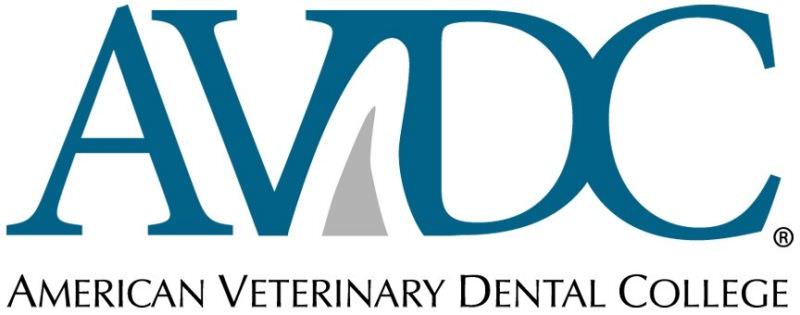
How does someone become a Veterinary Dentist?
A veterinary dentist is someone who completed an internship (or general practice equivalent) in addition to a residency in dentistry and oral surgery. Following successful completion residency, the doctor must pass rigorous written and practical examinations to become certified by the American Veterinary Dental College (AVDC).
What are the typical procedures a veterinary dentist would offer?
Services can vary depending on the individual, but typically, a veterinary dentist would offer the services listed below.
- Dental radiographs and comprehensive oral examinations and cleanings
- Routine and advanced tooth extractions
- Jaw fracture repair
- Periodontics (treatment of deep pockets and periodontal tissue loss)
- Prosthodontics (crowns)
- Endodontics (root canal therapy/treatment of broken teeth)
- Orthodontics (treatment of malocclusions)
- Oral tumor removal
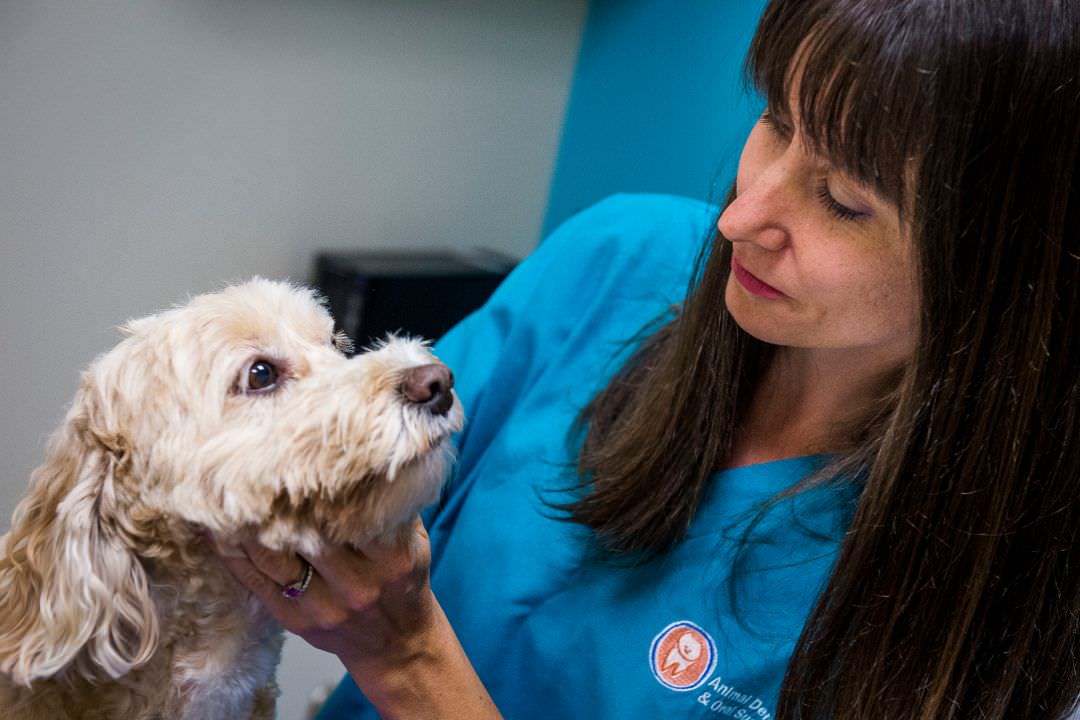
The loss of teeth is very upsetting for many pet parents, and understandably so. Losing teeth is a big deal, not only because removing teeth involves a complicated surgery under anesthesia, but because to us, as humans, losing teeth can a life-changing experience. I am here to ensure you that domesticated dogs and cats can live completely normal lives with few to no teeth!
Remember that our pets are carnivores and do not chew like humans. Humans are chewers and grinders. Carnivores are cutters and gulpers. Our pets have an existing mechanism for swallowing food whole, and many cats and dogs with perfectly normal teeth do very little to no chewing! Dogs and cats do not use their teeth like we humans do, so it is important that we not compare our pets to ourselves when deciding on appropriate care for them. They can continue to eat normal food after a few or all extractions.
Facts to consider:
- Teeth do not shift following extractions like they do in people.
- The diets we feed our domestic dogs and cats can easily be eaten without some or all teeth.
- The gums harden up and dogs can chew with those if needed. My little dachshund that lost all of her teeth by the age of 8 still chewed on bones!
- Bad teeth in the mouth cause pain and infection, so leaving them in doesn’t provide for better chewing or function.
In short, if your dog or cat requires extractions, do not fear. They will likely feel much better after bad teeth are removed from the mouth and will function and look even better!
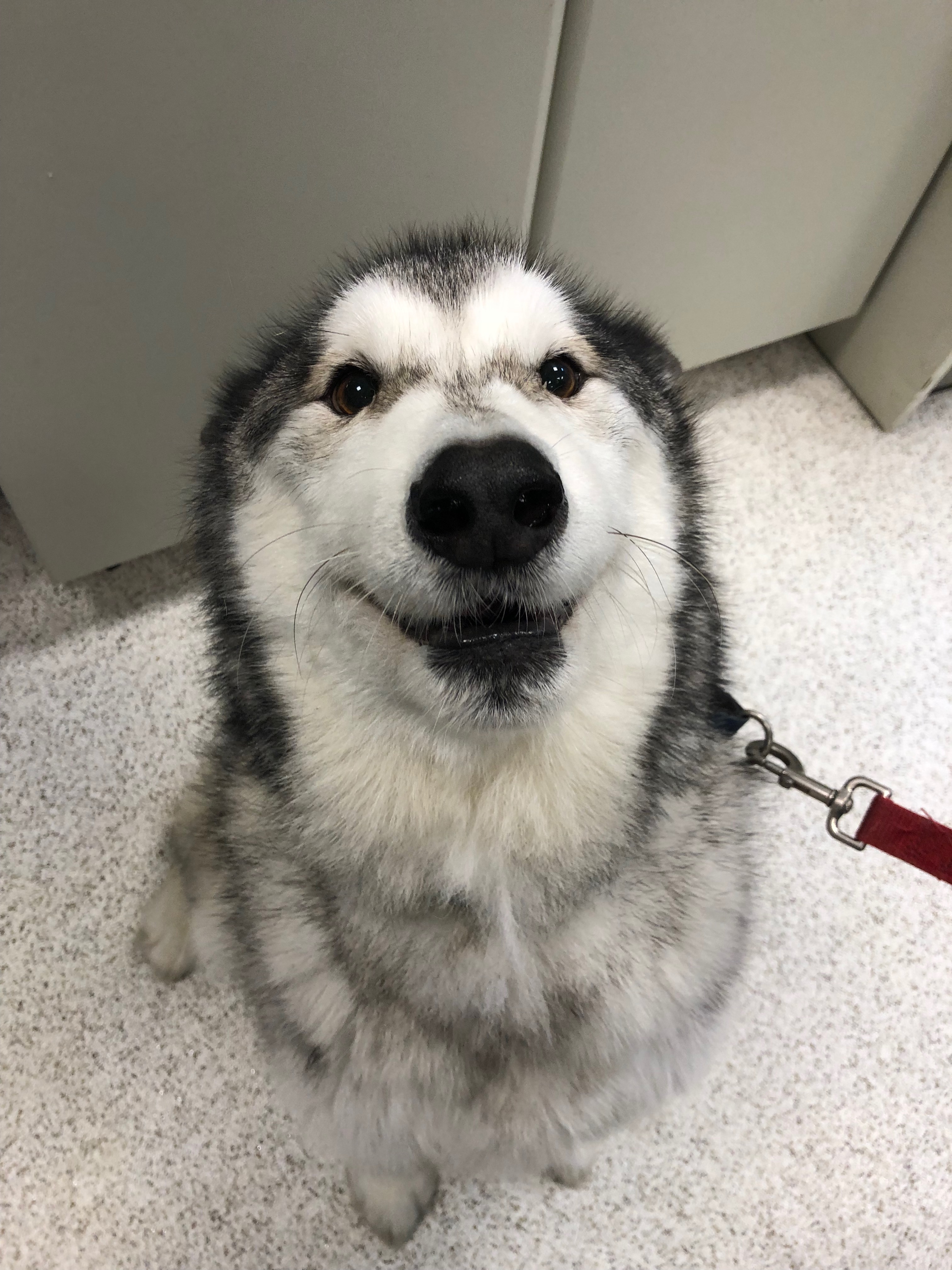
The handsome Malamute pictured above is one of our favorite patients, Hunter. Hunter had severe periodontal disease which necessitated the removal of all of his teeth by the age of 5. Hunter is amazingly resilient and felt so much better after all the disease was removed. He howled happily at us and begged for cookies at his recheck visit! He’s a great example of how dogs and cats feel so much better after diseased teeth are removed!
